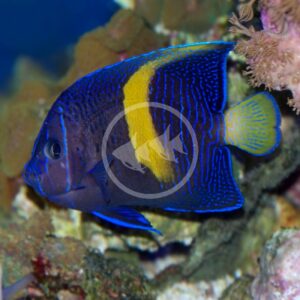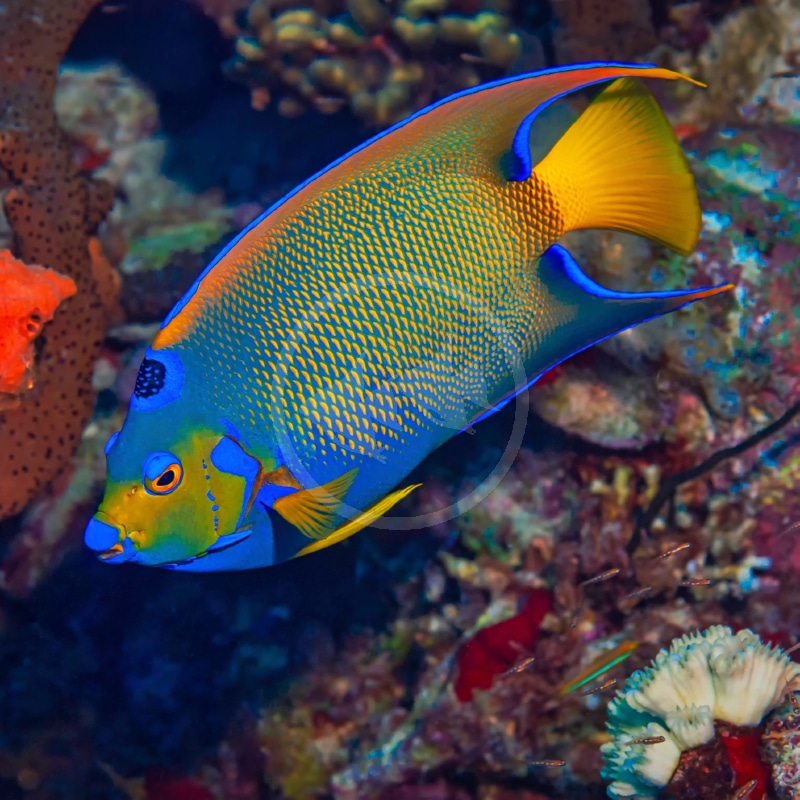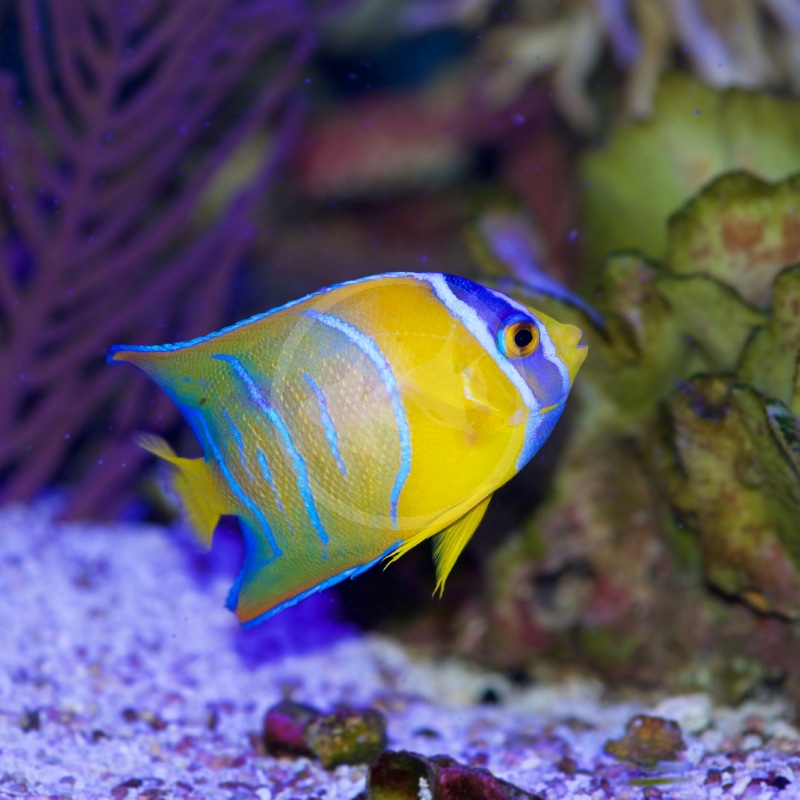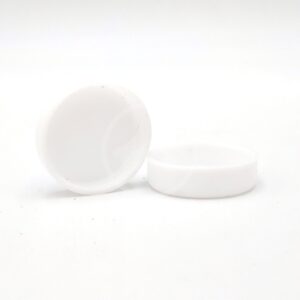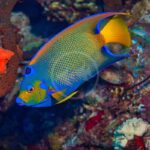
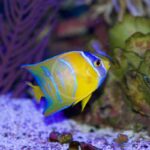

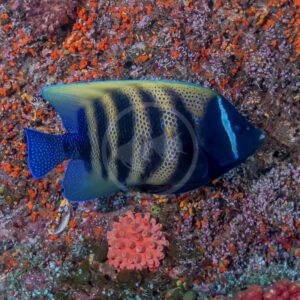
ANGEL – QUEEN Holacanthus ciliaris
$249.99
The Queen Angelfish is one of the most recognizable and beautiful of all large angelfish. Found in the Western Atlantic Ocean. They range from Florida south through the Caribbean Sea and Gulf of Mexico to the northern coast of South America. Its range extends as far east as Bermuda and Brazil’s St Paul’s Rocks. Vibrant yellow and blue highlights give the adult Queen Angelfish an almost iridescent appearance. It has a dark spot on the forehead surrounded by bright blue. The dorsal and pelvic fins are elongated and pointed. Juvenile coloration is a yellow in the front of the body turning brownish yellow halfway between the head and the vivid yellow tail, the pectoral fin being a similar bright yellow. They are marked with a number of narrow ligh blue vertical stripes. The dorsal and anal fins have vivid blue edges. Adults have the potential of reaching an impressive 18 inches in length.
Care Level: Moderate
Temperament: Semi-Aggressive
Reef Compatible: No
General Description: The Queen Angelfish is one of the most recognizable and beautiful of all large angelfish. Found in the Western Atlantic Ocean. They range from Florida south through the Caribbean Sea and Gulf of Mexico to the northern coast of South America. Its range extends as far east as Bermuda and Brazil’s St Paul’s Rocks. Vibrant yellow and blue highlights give the adult Queen Angelfish an almost iridescent appearance. It has a dark spot on the forehead surrounded by bright blue. The dorsal and pelvic fins are elongated and pointed. Juvenile coloration is a yellow in the front of the body turning brownish yellow halfway between the head and the vivid yellow tail, the pectoral fin being a similar bright yellow. They are marked with a number of narrow ligh blue vertical stripes. The dorsal and anal fins have vivid blue edges. Adults have the potential of reaching an impressive 18 inches in length.
Diet Requirements: In the wild they feed on various invertebrates such as sponges, tunicates, jellyfish, and corals, and also on plankton and algae. Analysis of stomach contents has indicated that most of their natural diet comprises sponges. The aquarium diet of the Queen Angelfish should include Spirulina, Chlorella, marine sheet algae, high-quality angelfish preparations with sponge, mysis or enriched frozen shrimp, and other meaty items. Flake or pellet foods can also be offered for variety. Feed small meals three times daily to help reproduce their natural grazing behavior.
Care Requirements: The Queen Angelfish requires a large tank as an adult, a minimum of 200 gallons and 18+ inches width, with lots of hiding places and live rock for grazing. It can be aggressive, so it must be introduced to the community tank last. Not a good reef dweller, the Queen Angelfish is prone to nipping at stony and soft coral polyps, clams and other sessile invertebrates. Recommended water conditions, 72-78° F, KH 8-12, pH 8.1-8.4, salinity 1.020-1.025.
Purchase Size: Juvenile Small: 1″ to 1-1/2″; Medium: 1-1/2″ to 2-1/4″; Large: 2-1/4″ to 3-1/4″; Adult Small: 3″ to 3-1/2″; Medium: 4″ to 5″; Large: 5″ to 6″; XLarge: 6″ to 7″
Note: Your item may not look identical to the image provided due to variation within species. Purchase size is approximate.
Dry goods orders are shipped via US Postal Service or UPS to the address provided at checkout based on the selection made in your website shopping cart. Product is carefully packed to help prevent any damage during shipping. Once processed you will receive a shipment notification via email with tracking number, and delivery notification. Please allow 48 hours for processing after your order is placed.
Perishable items (i.e. live plants, refrigerated/frozen foods) are shipped via US Postal Service 2-3 day to the address provided at checkout for a $25.00 flat rate charge. Items are packed with secure packing material and heat, cold, or Cryo packs as needed to maintain safe temperatures during transit. If one or more perishable items are in the shopping cart at checkout the $25.00 perishable shipping charge will automatically appear and need to be selected. Once processed you will receive a shipment notification via email with tracking number. Please allow 48 hours for processing after your order is placed.
Livestock (i.e. fish, invertebrates, coral) are shipped via UPS Overnight to the address provided at checkout for a $55.00 flat rate charge. Livestock is packed in insulated styrofoam boxes with secure packing material and heat, cold, or Cryo packs as needed to maintain safe temperatures during transit. If one or more livestock items are in the shopping cart at checkout the $55.00 livestock shipping charge will automatically appear and need to be selected. Livestock is shipped Monday through Wednesday ONLY (no weekend delivery is available) weather permitting, and we reserve the right to delay shipping until conditions are appropriate for safe arrival. Once your order is placed we will contact you to arrange the best shipping date based on these criteria. Someone must be available to receive the livestock order on the first delivery attempt. Once processed you will receive a shipment notification via email with tracking number. Please allow 48 hours for processing after your order is placed.
For mixed dry goods/perishable & livestock orders items will be shipped via their corresponding shipping methods outlined above. Dry goods will be shipped via US Postal Service or UPS based on your selection and checkout, while livestock will ship via UPS Overnight for a $55.00 flat rate charge. You will receive separate notifications and tracking numbers for the dry goods and livestock. Please note due to different carriers and shipping methods dry goods and livestock may arrive on different days.
Related products
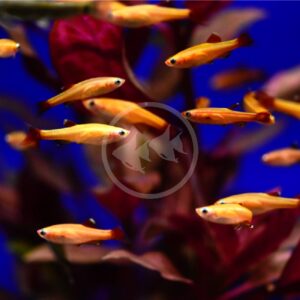
MINNOW – WHITE CLOUD MOUNTAIN GOLD
Tanichthys albonubes
$5.99
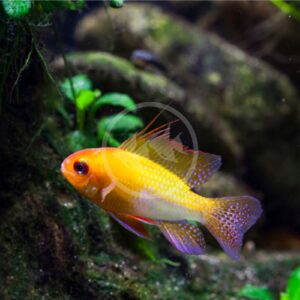
CICHLID – RAM GERMAN GOLD
Mikrogeophagus ramirezi
$11.99 – $16.99
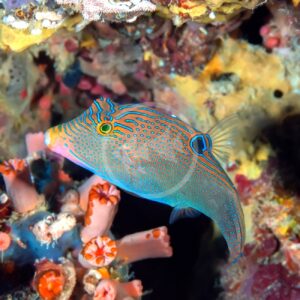
PUFFER – BLUE SPOT Canthigaster solandri
$89.99 – $149.99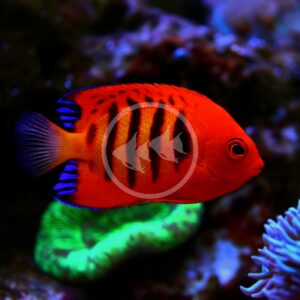
ANGEL DWARF – FLAME Centropyge loriculus
$149.99 – $199.99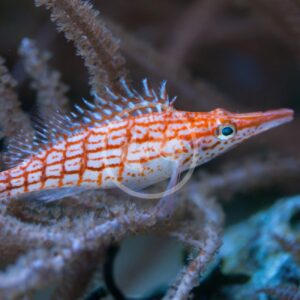
HAWK – LONGNOSE Oxycirrhites typus
$129.99 – $149.99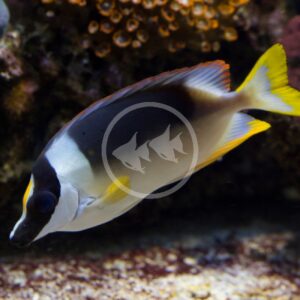
RABBITFISH – MAGNIFICENT FOXFACE Siganus magnificus
$249.99 – $349.99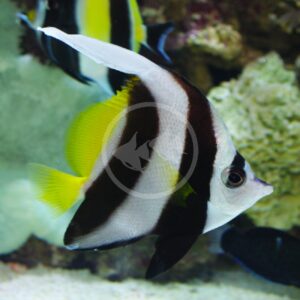
BUTTERFLY – HENIOCHUS BLACK & WHITE Heniochus acuminata
$119.99 – $249.99